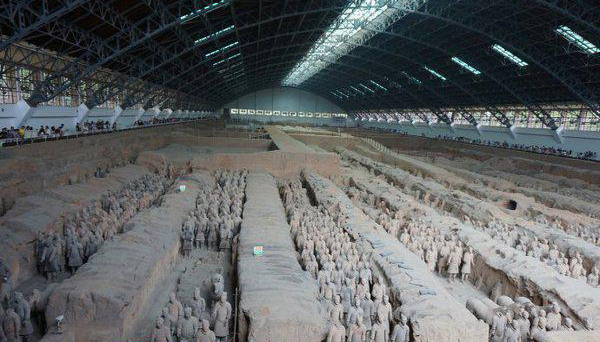
About XI'AN
The temperature record of the previous year- XI'AN on November
Xi'an, formerly known as Chang'an and Bianjing, is an important national center city in the capital of Shaanxi, a sub-provincial city, a key city group in the Guanzhong Plain, and an important national center city in the western part of China. It is also an important national scientific research, education, and industrial base. Xi'an is one of China's four ancient capitals, and the UNESCO World Heritage City was established in 1981. It is one of the top ten ancient capitals in the world.
Xi'an is located in the middle of the Guanzhong Plain, north of the Wei River, south of the Qinling Mountains, and eight waters running Chang'an. Under the jurisdiction of 11 districts and 2 counties, the total area of 10108 square kilometers. It has economic and industrial highlands such as Xixian New District, Shaanxi Free Trade Zone and Xi'an Port. At the end of 2016, the resident population was 8,831,100, of which the urban population was 6,485,400.
Chang'an has been an imperial capital since ancient times. It has successively established the capitals of the Western Zhou Dynasty, Qin Dynasty, Western Han Dynasty, Xinyi, Eastern Han Dynasty, Western Jin Dynasty, Qianzhao, Qianqin, Houqin, Xiwei, Beizhou, Sui and Tang dynasties. It is the birthplace of the Chinese civilization and the Chinese nation and the starting point of the Silk Road. Fengchang Capital City, Qin Afang Palace, Terracotta Warriors, Hanweiyang Palace, Changle Palace, Daxing City, Tang Daming Palace, Xingqing Palace, etc. outline the “Chang'an complex”.
Xi'an is one of China's best tourist destinations and a national civilized city. Two of the six heritage sites have been listed on the World Heritage List: Qin Shi Huang Mausoleum and Terracotta Warriors and Horses, Giant Wild Goose Pagoda, Small Wild Goose Pagoda, and Tang Changcheng Daming Palace. Sites, Han Chang'an City Weiyanggong Site, Xingjiao Temple Tower. There are Xi'an City Wall, Bell and Drum Tower, Huaqing Pool, Zhongnan Mountain, Datang Furong Garden, Shaanxi History Museum, Xi'an Stele Forest and other attractions. Xi'an is also an important science and education center in the country.
The Terra Cotta Warriors
The Terra Cotta Warriors and Horses are the most significant archeological excavations of the 20th century. Work is ongoing at this site, which is around 1.5 kilometers east of Emperor Qin Shi Huang's Mausoleum, Lintong County, Shaanxi province. It is a sight not to be missed by any visitor to China.
The museum covers an area of 16,300 square meters, divided into three sections:No.1 Pit,No.2 Pit, and No.3 Pit respectively. They were tagged in the order of their discoveries.No.1 Pit is the largest, first opened to the public on China's National Day, 1979. There are columns of soldiers at the front, followed by war chariots at the back.
No.2 Pit, found in 1976, is 20 meters northeast of No.1 Pit. It contained over a thousand warriors and 90 chariots of wood. It was unveiled to the public in 1994.Archeologists came upon No.3 Pit also in 1976,25 meters northwest of No.1 Pit. It looked like to be the command center of the armed forces. It went on display in 1989, with 68 warriors, a war chariot and four horses.
Altogether over 7,000 pottery soldiers, horses, chariots, and even weapons have been unearthed from these pits. Most of them have been restored to their former grandeur.
The Terracotta Warriors and Horses is a sensational archeological find of all times .It has put Xian on the map for tourists. It was listed by UNESCO in 1987 as one of the world cultural heritages.
Huaqing Palace (Huaqing Pool Lishan)
Huaqing Palace (Huaqing Pool Lishan) is located 30 kilometers east of the city of Xi'an, adjacent to the terracotta warriors, the eighth wonder of the world. It is the first batch of 5A class tourist attractions, national key scenic spots, national key cultural relics protection units and national cultural industry demonstration base. In the Zhou Dynasty, emperors of Qin, Han, Sui and Tang dynasties built the Farewell Court to the Palace. Because of its invariable hot spring resources, historical allusions of beacon fire opera princes, love stories between Tang Ming Emperor and Yang Guifei, and the place where the "Xi'an Incident" took place, it has become a landmark scenic spot of cultural tourism of the Tang Palace in China.
The Big Wild Goose Pagoda Dacien Temple
The Big Wild Goose Pagoda Dacien Temple is a landmark building in Xi'an and a must-see place for tourists. Upon the top of the tower, you can see the ancient capital Chang'an from a distance.
Dacien Temple is the most famous and magnificent Buddhist temple in Chang'an City of Tang Dynasty. It was built in the 22nd year of Emperor Taizong's Zhenguan (648), and has a history of more than 1300 years. Xuanzang of the Three Tibets in Tang Dynasty once presided over the temple affairs and led the translation of Buddhist sutras. He personally supervised the construction of the Big Wild Goose Pagoda in the temple, and created the Mahayana Buddhism Tzu En Sect. This Temple became the holy place of Mahayana Buddhism in China. Therefore, the Daci En Temple has a very prominent position in the history of Chinese Buddhism.
Lotus palace of Tang Dynasty(Tang Paradise)
Tang Paradise lies in the Qujiang New District, Xi’An City, Shanxi Province, with 66.7 hectares building areas and 20 hectares of lake areas inside. The garden is the biggest culture theme part in Northwest China, with 1.3 billion RMB investments. The Tang Paradise, which was rebuilt at the north of archaeological site of Lotus Palace of Tang Dynasty, is the first large scale royal garden culture theme garden which fully exhibits the living styles and features if Glorious age of Tang Dynasty.
In this project, we created a unique night view of “Splendid and magnificent, Glorious age of Tang Dynasty”, by fully controlling the combination of “Lighting” and “Shadow”











